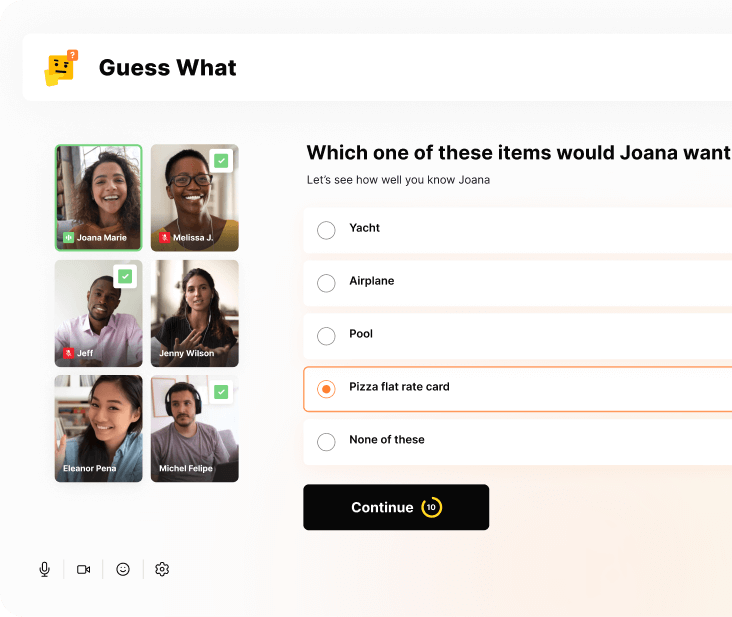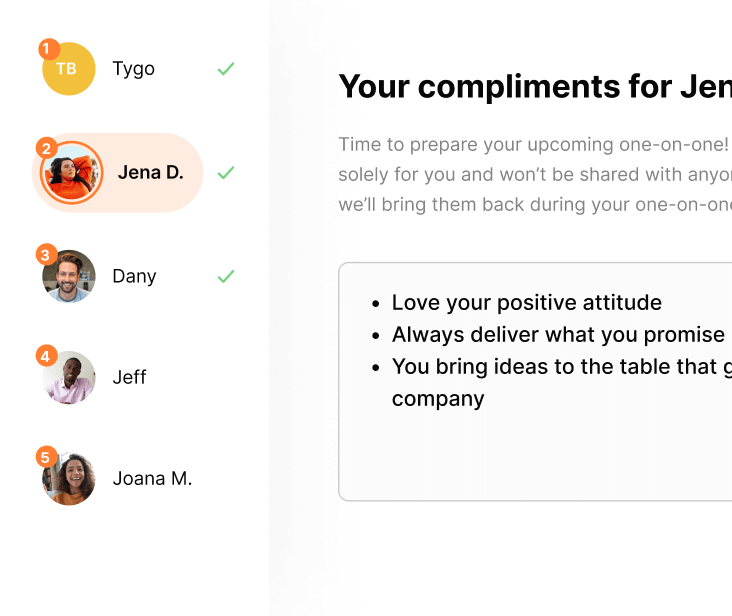Back to Blog
How to improve employee engagement in 6 science-backed steps
It’s helpful for employees to be happy at work, but that’s rarely enough to create a successful company. Happiness alone won’t ensure that a worker is highly focused and interested enough in the job to stay.
Instead, what employers want to create is engagement.
Research shows that engaged employees feel committed to and identify with an organization. These engaged employees are also satisfied and energized in their work.
But how do you improve employee engagement?
6 factors to improve employee engagement
Research by Deloitte has identified different factors that make it more or less likely for you to see employee engagement rise. First, they surveyed different groups of employees about criteria like commitment to their organization. Then, they looked at whether these employees received high marks on performance reviews and stayed with their companies instead of hopping into a new job.
From this research, the Deloitte team identified 5 patterns in what matters to keeping employees engaged or improving employee engagement if it is currently low.
- Trust in leadership
- Supportive management
- Meaningful work
- Positive work environment
- Growth opportunity
For each category, we’ve offered key actions necessary to achieve high levels of employee engagement. We also share strategies to increase employee engagement to gain a sixth factor: overall loyalty to the company. Some strategies will quickly enhance employee engagement. Others are long-term fixes that will help over time as you hire, train, and promote new people.
Share fun facts and bond with a team quiz
Have your participants choose from a list of questions they’d like their coworkers to answer about them, before watching as they guess the right answer.
01. Yes
share-fun-facts-and-bond-with-a-team-quiz

Run a guided recognition activity
Have your participants choose from a list of questions they’d like their coworkers to answer about them, before watching as they guess the right answer.
01. Yes
run-a-guided-recognition-activity

Organize a virtual cooking class
Hire a professional chef to help your team cook a delicious lunch or dinner. May be difficult for co-workers with families. To find providers and get tips, read our blog about virtual cooking classes.
02. No
organize-a-virtual-cooking-class

Hire a stand-up comedian
Have your participants choose from a list of questions they’d like their coworkers to answer about them, before watching as they guess the right answer.
02. No
hire-a-stand-up-comedian

No items found
No items found
Table of contents
It’s helpful for employees to be happy at work, but that’s rarely enough to create a successful company. Happiness alone won’t ensure that a worker is highly focused and interested enough in the job to stay.
Instead, what employers want to create is engagement.
Research shows that engaged employees feel committed to and identify with an organization. These engaged employees are also satisfied and energized in their work.
But how do you improve employee engagement?
6 factors to improve employee engagement
Research by Deloitte has identified different factors that make it more or less likely for you to see employee engagement rise. First, they surveyed different groups of employees about criteria like commitment to their organization. Then, they looked at whether these employees received high marks on performance reviews and stayed with their companies instead of hopping into a new job.
From this research, the Deloitte team identified 5 patterns in what matters to keeping employees engaged or improving employee engagement if it is currently low.
- Trust in leadership
- Supportive management
- Meaningful work
- Positive work environment
- Growth opportunity
For each category, we’ve offered key actions necessary to achieve high levels of employee engagement. We also share strategies to increase employee engagement to gain a sixth factor: overall loyalty to the company. Some strategies will quickly enhance employee engagement. Others are long-term fixes that will help over time as you hire, train, and promote new people.
1. Trusting the leadership in place
You want to be the kind of leader who positively impacts your team. This starts with the ability to showcase the mission and purpose of the company. Such transparency can inspire everyone else to feel engaged.
Other factors include your investments in your team. Are you encouraging them to seek professional development? Are employees allowed to make time in their workday for them to get replenished?
Finally, leadership trust is deeply connected to honesty. It’s much easier to hide some inconvenient experiences in business. When it comes to light that you haven’t been honest, your team may struggle to trust you again.
How to improve employee engagement in the workplace through trustworthy leadership:
- Look for opportunities to be more open about reasons behind big decisions. This openness gives employees a peek into your careful decision-making.
- Get employee feedback on big changes at work. Use critical feedback to make visible changes. Don't just reward those who already trust leadership.
2. Feeling supported by your supervisor
If you’ve ever heard someone say they quit because they had a “bad boss,” it’s likely related to this factor.
Great supervisors help their teams set and achieve goals. Let's say a certain standard is set as the way someone will get promoted. A supervisor should be helping employees see where they are and are not meeting the standard. Reaching goals requires coaching. Coaching well may mean you, as a supervisor, need some training on managing well.
Support can also look like sharing timely information and transparency. You may need to make a case for your team to the higher-ups. You also may need to advocate for additional resources, like budget, new personnel, or extra time to complete projects.
How to encourage employee engagement through supervisory support:
- Take a careful look at how your different employees got into their current roles and have grown internally. What might they need from you to continue their growth? Recognize that even self-starters need things from their supervisors, and if you can anticipate those needs, you may retain them for longer.
- Invest in professional development related to your management structure. Supervisors need to have enough time allocated to do their own tasks and manage well.
3. The meaningful nature of the work
Many people find work meaningful because it helps someone. They may like that they create a product or service that improves people’s lives. Some work is too abstract or distant to feel meaningful automatically. Still, you can make work more meaningful in many ways, increasing employee engagement.
One of those ways is by offering autonomy instead of micromanaging employees. Autonomy creates happy workers that own their work products more proudly. The same can be true for teams that aren’t managed too rigidly. When a team makes a good decision, they feel they’ve had a meaningful impact.
How to encourage employee engagement through meaningful work:
- Whenever possible, use internal messaging that helps your employees see the positive impact you, as a business, have. Winning them over to the benefits of your company’s work can help them bring a strong attitude to work.
- Experiment with giving team members the freedom to solve problems with less managerial input. Of course, keep strong communication about what’s happening.
4. Positivity at work
Positive workplaces aren’t simply people who smile all the time. Instead, these workplaces go past slogans and hype and foster a culture of positivity.
- They are positive about employees needing flexibility to live their lives and do their best work.
- Great workplaces emphasize respect and have protections to ensure workplace bullying cannot thrive.
- Positive workplaces have a culture of recognizing talent and giving praise specifically.
- Positive employers notice if things are unfair or exclusive. They then change those structures to create a more open and accepting place to work.
Strategies to increase employee engagement through positivity:
- Create a well-informed diversity and inclusion policy and set of procedures and goals. These policies often promote treating teams in a welcoming way. Over time, find and remove practices that create unnecessary competition or conflict.
- Consider using employee engagement apps that offer easy coworker recognition.
- Sometimes, a management team is frustrated and brings negative energy to interactions with their teams. Consider how a change in policy could create space for more positive interactions. For instance, perhaps management is coming down hard on lateness. Find a way to create an incentive structure for being on time rather than a harsh conversation for every tardy day.
5. Potential for growth
Some companies don’t consider how much high-performing employees want to learn and change over time. If your company is structured with little room for promotion, you’re likely to lose some staff when they realize there isn’t anywhere “up” for them to go. So, help new entry-level staff see they can make a decades-long career here.
How can an organization improve its employee engagement rate through growth potential?
- Pull out the organization chart and figure out what each person will likely be doing in a year, two years, or even five years. Can roles be shuffled over time to make room for internal high performers to grow? Implement those changes.
- Perhaps leadership roles are few and far between. Consider how cross-training, professional development, and coaching could help your teams. These opportunities help their jobs and responsibilities feel fresh. This keeps things from feeling stagnant.
6. The connecting factor: loyalty and identity with the work
This final factor is the connector, which emerges when all the others are present. It’s easy to claim that you want your team to be loyal and identify with the job or the work. However, it’s harder to actually create this loyalty and identity. Employees may “fake” brand loyalty right up until they are handing in their notice.
Creating real identification with the work involves all the above factors. It's not just about demanding that everyone who works for you uses your products personally.
Here are some spontaneous signs that you’ve figured out how to get employee engagement through loyalty:
- Employees are referring friends to work with you even if there isn’t an incentive to do so.
- Employees who bring healthy debate and disagreement during the decision-making. They then support the decision 100% in public.
- Employees who don’t just tell their supervisors what they want to hear. With their hard truths, they also bring potential solutions.
How to boost employee engagement through loyalty:
- Look at your hiring process and see if there are ways to add weight to those who know, appreciate, or clearly value your work. It shouldn’t be the only factor in a hiring decision. But, you may get longer-term loyalty from a candidate who thinks this work is important and feels a personal bond.
- Give your employees space to voice concerns anonymously. Then, address them all in a transparent way. If no one has anything to say, there may be loyalty/trust issues. After all, every company has areas for potential growth.
Your teams crave connection. Give them a chance to build their bonds.
As you can see, there isn’t just one factor among many ways to get employee engagement. Instead, the vision at the top, support from supervisors, and connection to the work all contribute. Coworkers matter too, and if you don’t know your coworkers, it’s hard to trust them and value them. Team building on a virtual platform can go a long way to promoting employee engagement. Even casual games and activities create a bond that makes for long-term satisfaction. Try Gomada’s team building activities today to energize and connect your employees.
Subscribe to get our latest updates
Subscribe to get our latest updates
.webp)





